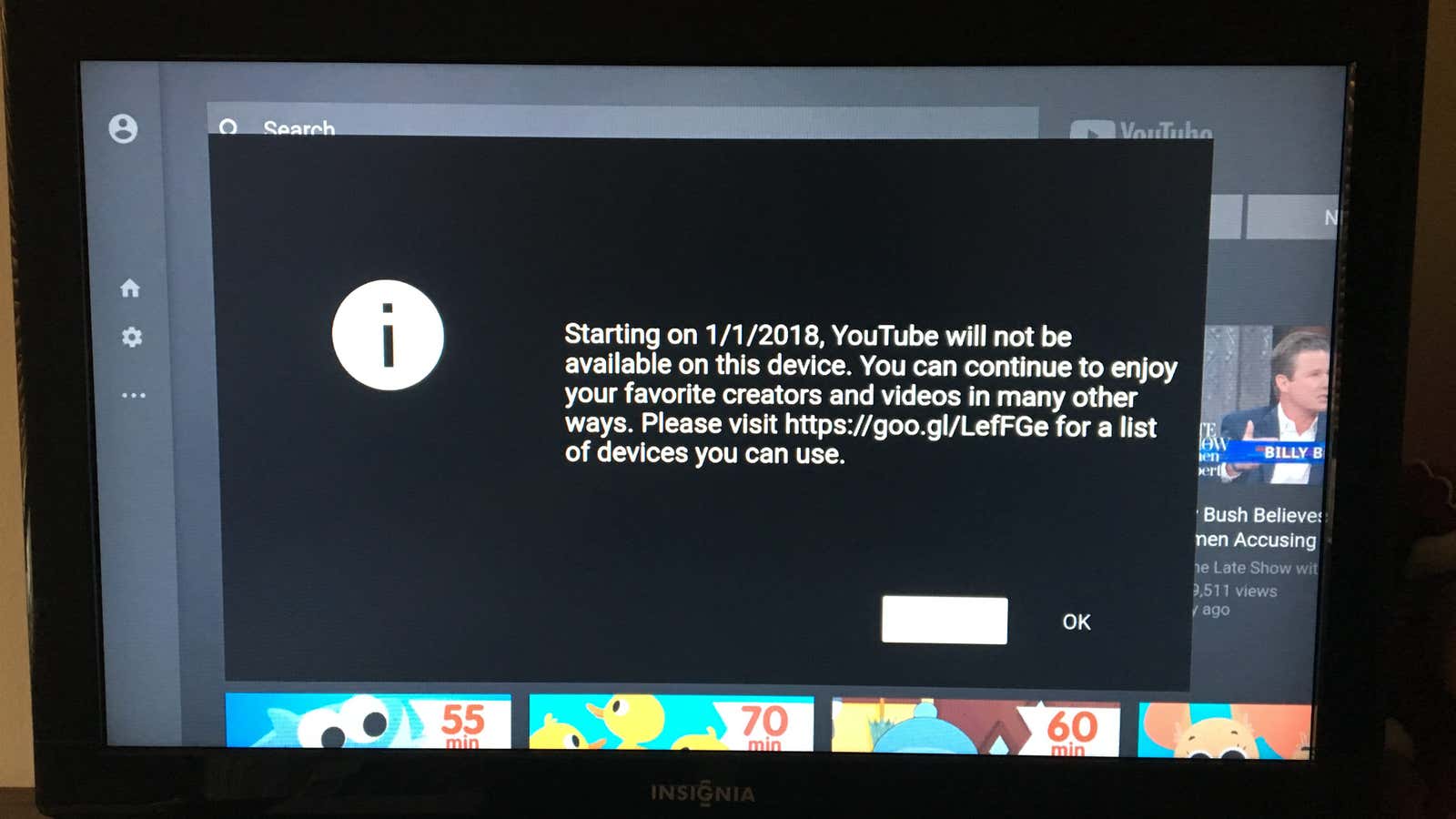If you tried to watch YouTube on an Amazon Fire TV this week, you probably encountered a disconcerting message: “Starting on 1/1/2018, YouTube will not be available on this device.” It directed viewers to a list of other smart TVs, media players, game consoles, and set-top boxes, where Google’s exceedingly popular video app is still available. Amazon devices were not on it.
Years of squabbling between the rival tech companies, which make and sell competing media players that carry each other’s streaming apps, has finally driven Google to the point of pulling YouTube—the US’s most-watched streaming app—from Amazon’s Fire TV and Echo devices.
Customers are the ones losing out. YouTube users will no longer be able to watch their music videos, unboxing segments, cat clips, and other videos on Amazon devices. Amazon Prime Video subscribers already can’t use the Google Chromecast to stream to their TVs because Amazon doesn’t support it.
Customers aren’t pleased with either Google or Amazon.
This kind of infighting isn’t uncommon among streaming players. Apple TV owners are only now able to access movies and videos they subscribe to through Amazon Prime or paid for through Amazon’s online-video stores, which rivals iTunes, even though both have been on the market for years. Prior to that, the only way to watch Amazon Prime on an Apple TV was to Airplay the platform through another device, like a laptop or smartphone, to a TV. It’s a rather annoying way to binge-watch.
Not having Amazon Prime Video put the Apple TV at a disadvantage compared to other streaming players like Roku that carried all the major apps, including Amazon Prime Video and YouTube. That, and cheaper devices, helped Roku become one of the top streaming-device makers in the US.
The continued feuding may hurt Amazon and Google heading into the holiday season as well, as consumers look for streaming-TV devices to buy that don’t limit what they can watch.
The latest dustup between Google and Amazon stems from the latter’s refusal to sell several Google devices that compete with its own on its e-commerce site, which is one of the world’s largest. It hasn’t sold Google Chromecast devices (or Apple TVs) since 2015, because they were not compatible with its video service. It removed Google’s latest Nest smart-home kit from its shopping site last month (no reason was given, but it happened around the same time Amazon launched Key (paywall), which is seen as something of a competitor). It doesn’t carry the Google Home, which rivals Amazon’s own Echo devices. A search for the Google Home via Amazon’s virtual assistant Alexa instead surfaces Echo devices. And YouTube was pulled from the Echo Show earlier because Google wasn’t happy with the implementation (paywall), which prevented users from logging in and commenting.
“We’ve been trying to reach agreement with Amazon to give consumers access to each other’s products and services,” a Google spokesperson told Quartz. “But Amazon doesn’t carry Google products like Chromecast and Google Home, doesn’t make Prime Video available for Google Cast users, and last month stopped selling some of Nest’s latest products. Given this lack of reciprocity, we are no longer supporting YouTube on Echo Show and FireTV. We hope we can reach an agreement to resolve these issues soon.”
Amazon told Quartz its Fire TV and Echo Show devices will display a standard web view of YouTube.com—what you’d see when visiting the site on a browser—and direct customers to YouTube’s website. “Google is setting a disappointing precedent by selectively blocking customer access to an open website,” a spokesperson said. “We hope to resolve this with Google as soon as possible.”
